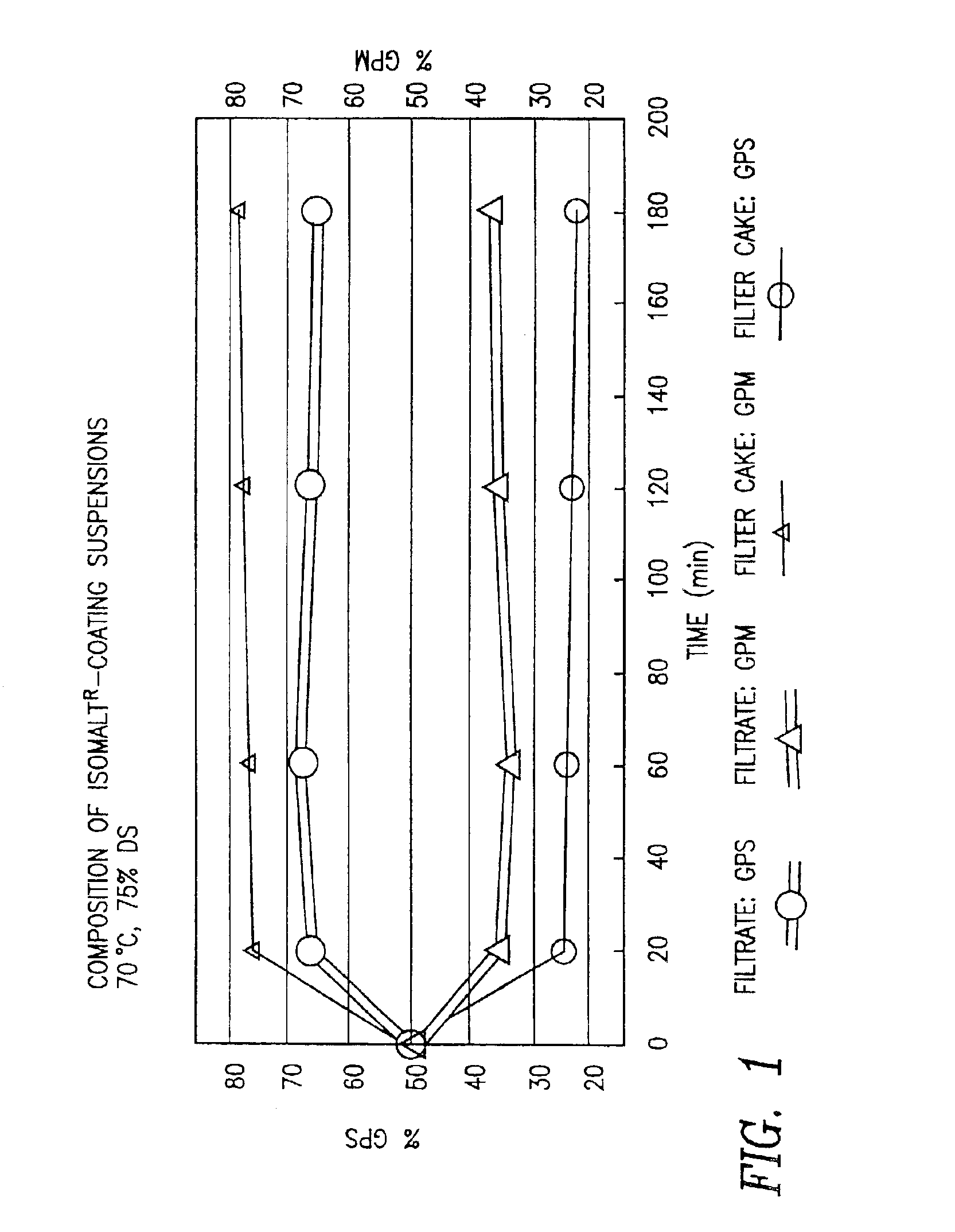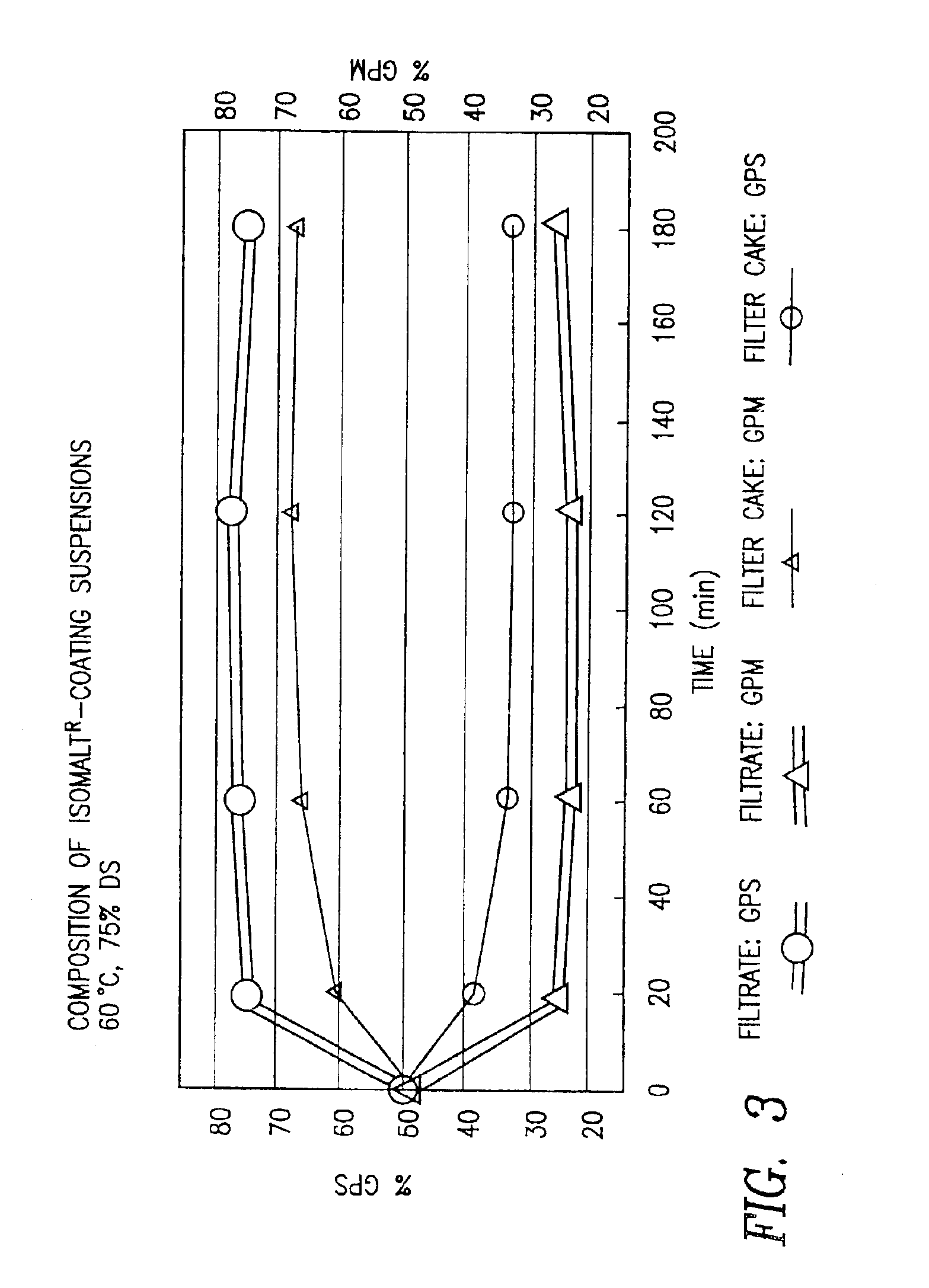Sugar-free products with improved characteristics
a technology of improved characteristics and sugar-free products, applied in the field of improved sugar-free products, can solve the problems of complex processing execution, adhesion tendency upon application of aqueous solutions, and complex processing, and achieve the effect of desired solubility characteristics
- Summary
- Abstract
- Description
- Claims
- Application Information
AI Technical Summary
Benefits of technology
Problems solved by technology
Method used
Image
Examples
example 1
Production of 1,1-GPM- and 1,6-GPS-enriched 1,1-GPM / 1,6-GPS Mixtures at 70° C. (with the Addition of Gum Arabic)
1920 g ISOMALT® Type M (hydrogenated isomaltulose) and 67.5 g gum arabic (rapidly soluble) are dissolved in 670.8 g water at 80° C. and subsequently cooled to 70° C. While stirring, 341.7 g ISOMALT® PF (powder) are added. The water content of 3.5 wt % in ISOMALTR was taken into consideration thereby.
After 60 min, the solid phase is separated from the liquid phase. This can occur, for example, by centrifugation or filtration.
In the example under consideration, the separation of the solid phase from the liquid phase is undertaken by filtration via a pressure filter tempered to 70° C. after 20, 60, 120, and 180 min. The compositions of the obtained phases are represented in Table I, below:
TABLE 1Sample1234Filtrate in g85.85100.89 130.83 100.9 Filter cake (moist)37.7651.5554.7632.34Filter cake (dry)34.3048.5652.1029.53Filtrate75.1:24.976.7:23.377:2374.5:25.5(1,6-GPS:1,1-GPM) %...
example 2
Production of 1,1-GPM- and 1,6-GPS-enriched 1,1-GPM / 1,6-GPS Mixtures at 35° C.
5 kg Isomalt® are added to 5 kg water (fully deionized). The suspension is stirred at 35° C. for 1-20 h, depending on the grain size.
Subsequently, this suspension is separated into the liquid and solid phases in a heated pressure filter at 35° C.
The clear solution is evaporated and dried in a rotary evaporator, perhaps subsequently comminuted.
1.95 kg white solid are obtained (water content before drying 24.8%, 1,1-GPM:1,6-GPS ratio 84:16%) and 7.86 kg clear solution (42.3° Brix, 1,1-GPM:1,6-GPS ratio 33.5:66.5%).
The separation of the two phases can take place also by means of a vacuum filter, centrifuge or by sedimentation.
examples 1 and 2
and FIGS. 1-5 illustrate that with a deliberate use of the reaction parameters, temperature and solids concentration, it is possible to obtain mixtures of a desired composition.
FIGS. 7 and 8 illustrate this advantage in accordance with the invention.
From these figures one can see at what ratio hydrogenated isomaltulose (ISOMALT®) is mixed with water and at what temperature this suspension must be maintained, so as to obtain a liquid phase with a certain 1,6-GPS:1,1-GPM ratio, for example.
If, for example, ISOMALT® is mixed with water at a ratio of 2:1, then an approximately 57° Brix solution with a 1,6-GPS:1,1-GPM ratio of 77:23%, i.e., 3,3:1 is obtained at a temperature of 45° C.
The same mixture, however, leads to an approximately 59° Brix solution with a 1,6-GPS:1,1-GPM ratio of 67:33%, i.e. 2:1, at 55° C.
PUM
 Login to View More
Login to View More Abstract
Description
Claims
Application Information
 Login to View More
Login to View More - R&D
- Intellectual Property
- Life Sciences
- Materials
- Tech Scout
- Unparalleled Data Quality
- Higher Quality Content
- 60% Fewer Hallucinations
Browse by: Latest US Patents, China's latest patents, Technical Efficacy Thesaurus, Application Domain, Technology Topic, Popular Technical Reports.
© 2025 PatSnap. All rights reserved.Legal|Privacy policy|Modern Slavery Act Transparency Statement|Sitemap|About US| Contact US: help@patsnap.com



